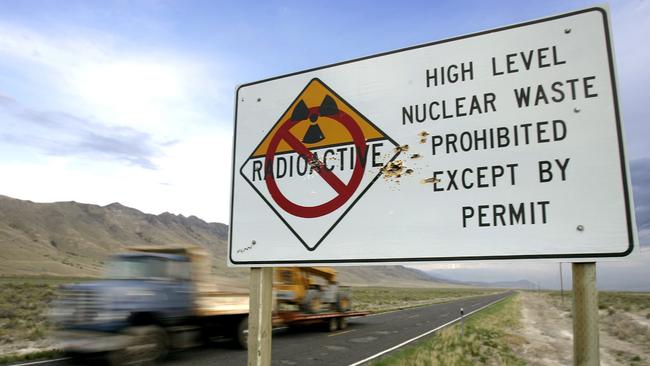South Australia could lead nation with nuclear power development
South Australia is crying out for a new industry to replace car manufacturing — it should be nuclear.

South Australia is crying out for a new industry to replace car manufacturing and give a once-great state some self-respect and influence again. South Australian wine is great, but it hasn’t been enough to wrench Adelaide out of the orbit of Melbourne and Sydney, which have progressively bought out its biggest companies, sucking away much of its managerial and professional class.
Becoming the state that powers the nation would be one way to restore self-esteem. The big disappointment in South Australia’s election campaign is that none of the major political parties has had the courage to declare South Australia a perfect site for Australia’s first electricity-generating nuclear reactor, one that could help power the eastern states.
Let’s face it, whoever wins the state election tomorrow won’t make much difference to the state’s long-term fortunes. A look at the major parties’ electoral platforms reveals the same rats-and-mice populist so-called policies that animate most state elections. Erode the payroll tax base here, a few tokenistic handouts there.
There’s not much difference between Liberal and Labor on energy. The Weatherill government wants to subsidise a big battery, the Liberal opposition wants subsidised small ones, having announced a $100 million plan to help households buy them.
Any of the three parties could have declared South Australia’s economic renaissance lay not in wind turbines and batteries, giant or small, but in a hi-tech nuclear reactor with a research facility hooked into the University of Adelaide. The bigger the better, ensuring the power could for generations provide no-emission, readily available energy to the National Electricity Market.
States have lost much of their financial clout to Canberra, but they do have freedom to zone, commission and subsidise.
South Australia could lobby the federal government to end the crazy law that makes Australia the only G20 country with a ban on nuclear energy, despite having among the largest uranium reserves in the world.
It could make the commonwealth’s life a lot easier by volunteering a site for a nuclear reactor. It could pick, say, Port Augusta, which would provide any reactor water access. It would also provide scope in decades to build or host a nuclear submarine fleet, if geopolitics developments required it. Port Augusta is a city suffering from huge economic and social problems, which could be allayed by the construction and operation of a state-of-the-art reactor.
None of the three major parties have even mentioned the “n” word in their policy platforms. Yet it’s not the political poison some think. A 2017 survey of households conducted by the Australian National University — the Beliefs and Attitudes Towards Science Survey — showed more than 41 per cent of Australians were in favour of nuclear power plants to generate electricity. Only 25 per cent were “strongly opposed”, and less than half were “against”. You read that correctly.
Remarkably, only 16 per cent of respondents were in favour of increased use of fracking, and almost 50 per cent were strongly against it. So why are we pursuing fracking and coal-seam gas?
A nuclear power station would cut long-term carbon emissions (some smarter Greens might even support it), bolster high-income STEM jobs, enhancing Australia’s national security and diversifying our energy supply. SA Labor had the foresight to have a royal commission into nuclear power. Its 2016 report sadly excited much debate. “The commission did not find that nuclear power is ‘too expensive’ to be viable or that it is ‘yesterday’s technology’. Rather, it found that a nuclear power plant of currently available size at current costs of construction would not be viable in the South Australian market under current market rules,” it reported. Nuclear energy isn’t being phased out. Nuclear power generation makes up a fifth of US electricity supply. China has 37 plans in operation and 20 under construction. About 40 new countries are showing strong interest in launching a nuclear power program for the first time, according to the World Nuclear Association.
Bangladesh has already poured concrete for its first nuclear reactor — with know-how supplied by Russia. Wouldn’t it have been nice if Australian engineers were being put to good use in that country of 170 million people? Of course, Britain is building nuclear reactors too.
Yes it’s expensive. But so are the subsidies to renewable energy, which don’t show up on government budgets but are no less real. The cost of federal and state subsidies to renewable energy are very hard to quantify in dollars, but they are large. And they are certainly large enough to have paid for construction of a nuclear power station by now, which would have solved many of our energy problems.
To build Australia’s first major nuclear reactor might even attract cut-price offers from firms eager for the knowledge. Nuclear energy is it’s 100 per cent reliable and 100 per cent emission-free. This is why countries like France, a big chunk of whose electricity is powered by nuclear fission, has such low per capita emissions and can sanctimoniously host summits about reducing global emissions.
South Australia couldn’t become a nuclear hub overnight. It’s a long-term goal. But preparation for it would lift the state’s importance within the country.




To join the conversation, please log in. Don't have an account? Register
Join the conversation, you are commenting as Logout